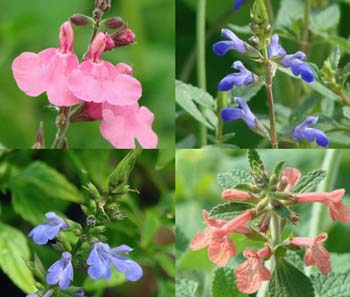Four Top Drought-Resistant Perennials for Dry Shade

Searching for shade-tolerant plants is difficult. Finding ones that grow well in dry conditions, especially as groundcovers, is even more challenging.
The four drought-resistant perennials described here include three Salvias and a closely related companion, which is also a member of the mint family (Lamiaceae).
All are comfortable in varying levels of shade. Despite not being made for foot traffic, these short plants handle other important groundcover tasks with finesse. When massed, they discourage weeds, conserve water by shading soil, provide color and add a finishing touch to your landscape.
Understanding Types of Shade
You'll find dry shade under trees, along fences, beneath deep roof overhangs and on the north side of buildings. A number of factors may cause dryness, such as:
- Tree and shrub roots that consume most of the soil's moisture
- Deep roof overhangs that limit rainfall from reaching the soil they shade
- A naturally dry climate and
- Drought that has dried soil throughout your yard.
Dry shade may include partial and full shade settings as well as locations with morning sun and afternoon shade.
Full sun is defined as direct sunlight for six hours or more a day. So a garden location with less than that amount of sun -- such as in the dappled sunlight under a shade tree -- would be considered partial shade.
Partial shade may be constant or shift to full sun at some times of day. Many mint family plants are adaptable from full sun to partial shade whereas others need partial shade throughout the day.
Full shade is the near absence of direct sun all day. Arizona Blue Sage (Salvia arizonica) is an example of one of the rare sages that tolerate full shade.
Mulching with Gravel
Some groundcovers, such as turfgrass or Horehound, form mats. However, the plants listed here are taller than mat-forming species and cover soil with spreading mounds of soft foliage.
Even if a plant is an efficient groundcover, it may need the boost provided by mulching its soil. Gravel is particularly good for drought-resistant plants, which thrive on its minerals and need mulch that doesn't mold. Gravel filters water quickly.
Mulching helps to suppress weeds while groundcover plants are first establishing roots and again each spring as they re-emerge.
Growing Living Mulches
Plant groundcovers sometimes are called "living mulches." Here are four favorite living mulches to team up with gravel to smother weeds and cool soil on hot days.Although drought-resistant, they appreciate some supplemental watering when rainfall is scarce.
Arizona Blue Sage (Salvia arizonica) Zones 6 to 11
- Lavender-blue flowers bloom summer to fall
- Mid-green, lightly veined foliage
- 24 inches tall and wide in bloom
- Partial to full shade or morning sun/afternoon shade
- Cold and heat tolerant
- Butterflies, honeybees and hummingbirds
Arizona Deep Blue Sage (Salvia arizonica 'Deep Blue') Zones 6 to 11
- Deep violet-blue flowers bloom summer to fall
- Mid-green, lightly veined foliage
- 24 inches tall and wide in bloom
- Partial shade or morning sun/afternoon shade
- Cold and heat tolerant
- Honeybees
Scorching Pink Mountain Sage (Salvia microphylla 'Heatwave Scorcher') Zones 6 to 9
- Hot pink flowers bloom summer to fall
- Dense green foliage
- 24 inches tall and wide in bloom
- Full sun to partial shade
- Heat tolerant
- Butterflies and hummingbirds
Hidalgo or 7-Up Plant (Stachys albumentosa)
- Creamy peach flowers bloom spring to fall
- Fragrant green foliage smells like 7-Up
- 20 inches tall and 18 inches wide in bloom
- Full sun to partial shade
- Butterflies, honeybees and hummingbirds
Making Your Plant Search Easier
Our catalog at Flowers by the Sea Online Nursery offers tools to simplify searches whether you need plants for full sun or full shade, drought or dampness. These include product filters that give you the ability to sort plants based on characteristics such as USDA zone, sun exposure, size, soil type, water needs, and heat tolerance. You'll find the filters when opening a category in the extensive menu on our homepage. An example of a category is Salvias by Culture, which includes subcategories such as "Drought Tolerant" and "Heat Loving."
Speaking of heat, if you've had a long, hot day in the garden, you might enjoy the cool-as-iced-tea music video at the bottom of this post. The Flute Choir of Washington State (who knew their were so many kinds of flutes?) performs Deep Space Heat Wave by Jonathan Cohen.
Then, if you have any questions that are raising your temperature, please call or email us. We'll help you chill promptly.

 Salvia microphylla 'Heatwave Scorcher'
Salvia microphylla 'Heatwave Scorcher'  Salvia arizonica 'Deep Blue'
Salvia arizonica 'Deep Blue'  Salvia arizonica
Salvia arizonica
Comments
There are no comments yet.